We’ve all been there – staring at a cluttered desk that seems impossible to tackle. Papers scattered everywhere, cables tangled like spaghetti, and that important document buried somewhere beneath yesterday’s coffee cup. A disorganized workspace doesn’t just look messy; it actively sabotages our productivity and mental clarity.
The good news? Transforming your chaotic desk into an organized powerhouse is easier than you think. With the right strategies and systems in place, we can create a workspace that not only looks professional but actually helps us get more done in less time.
Whether you’re working from home or in a traditional office setting, effective desk organization can revolutionize how you approach your daily tasks. We’re about to share proven techniques that’ll turn your desk from a source of stress into your secret weapon for peak performance.
Clear Your Desk Surface for Maximum Productivity
A clean desk surface serves as the foundation for enhanced focus and efficient workflow. We’ll explore three essential strategies that transform cluttered workspaces into productivity powerhouses.
Remove Unnecessary Items Daily
Dedicate five minutes each evening to clearing your desk of items that don’t belong there. Papers from yesterday’s meetings, empty coffee cups, and random office supplies quickly accumulate throughout the day. We recommend establishing a simple sorting system: keep only items you’ll need for tomorrow’s first task, file important documents immediately, and return borrowed items to their proper locations.
Establish a “one day only” rule for items on your desk surface. If something hasn’t been used within 24 hours, it should find a new home in a drawer, filing cabinet, or trash bin. This approach prevents the gradual buildup of clutter that eventually overwhelms your workspace and disrupts your concentration.
Create a quick checklist of items that never belong on your desk. Personal items like family photos work better on shelves or walls, while reference books should live in nearby storage. Snacks and beverages deserve their own designated area away from important documents and electronics.
Carry out the One-Touch Rule
Handle each piece of paper or digital notification only once when it crosses your desk. This productivity principle means you either act on it immediately, file it for later action, or discard it entirely. We’ve found this eliminates the common habit of shuffling the same documents around your workspace multiple times throughout the day.
Apply the one-touch rule to emails and digital files as well. When you open an email, decide whether to respond immediately, schedule it for later action, or delete it. Digital files should be saved to their proper folders right away rather than cluttering your desktop with temporary downloads and screenshots.
Set up simple action categories to support one-touch decisions. Create three basic options: do now (tasks taking less than two minutes), do later (scheduled tasks), and delegate or delete. This framework speeds up your decision-making process and prevents items from lingering in your workspace indefinitely.
Create Designated Zones for Different Tasks
Divide your desk into exact areas for different types of work activities. Establish a writing zone with your preferred pens and notepads, a computer zone optimized for digital tasks, and an inbox zone for incoming materials. We suggest using drawer organizers or desktop trays to maintain these boundaries visually and functionally.
Position your most frequently used items within arm’s reach of their designated zones. Your phone and calendar belong near your communication area, while project files should stay close to your primary work zone. This spatial organization reduces the time spent searching for tools and materials during busy workdays.
Maintain clear boundaries between zones to prevent overlap and confusion. Use small containers, desk mats, or even tape lines to mark different areas if needed. Each zone should contain only the tools and materials relevant to its exact function, creating a more efficient and organized workflow system.
Invest in Desktop Organizers and Storage Solutions
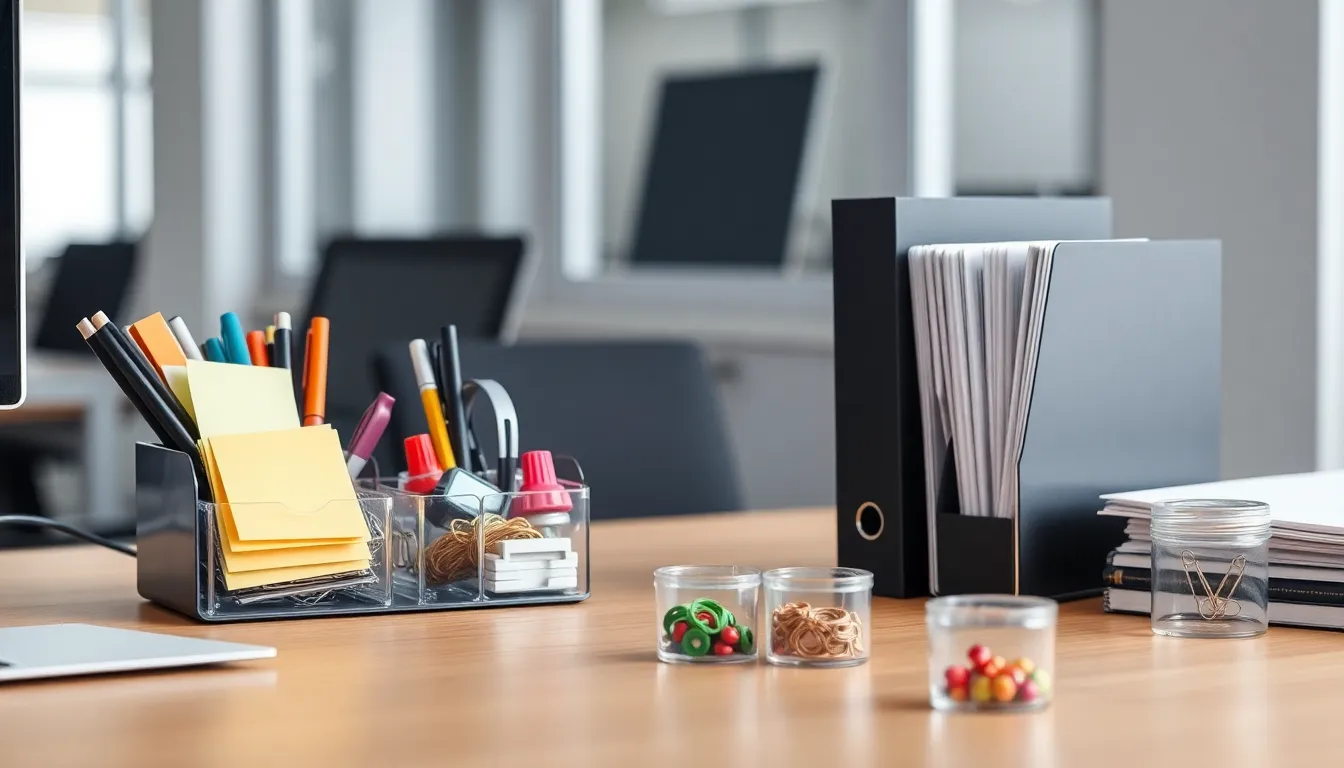
Building on our foundation of a clean desk surface, we need the right storage systems to maintain that organization long term. Smart desktop organizers and storage answers transform scattered supplies into an efficient workspace that supports our productivity goals.
Choose Multi-Compartment Desk Organizers
Multi-compartment organizers serve as the command center for our most essential desk items. These versatile storage answers help us categorize and separate different types of items like mail, files, and office supplies while keeping everything within arm’s reach. We recommend selecting organizers with at least 4-6 compartments to accommodate pens, paper clips, sticky notes, business cards, and charging cables.
Bamboo and acrylic organizers offer durability while maintaining a professional appearance that complements any office decor. Rotating desk organizers provide even more accessibility, allowing us to spin the unit to reach items on all sides without stretching or disrupting our workflow.
Add Vertical File Holders for Documents
Vertical file holders maximize our desk’s vertical space while keeping important documents organized and easily accessible. These storage answers prevent paper piles from accumulating on our work surface and help us locate exact files in seconds rather than minutes.
Magazine style file holders work perfectly for storing project folders, reference materials, and pending documents. We can arrange them by priority, project, or deadline to create a visual filing system that streamlines our document management. Wire mesh file holders offer excellent visibility of contents, while solid wood or plastic versions provide a cleaner aesthetic.
Desktop file sorters with multiple slots allow us to create an inbox, outbox, and action required system right on our desk surface. This approach keeps our workflow moving efficiently without sacrificing organization.
Use Small Containers for Office Supplies
Small containers eliminate the chaos of loose office supplies scattered across our desk drawers and surface. These compact storage answers keep paper clips, rubber bands, pushpins, and other tiny essentials organized and prevent them from creating visual clutter.
Glass jars, small plastic bins, and desktop trays work exceptionally well for this purpose. We suggest using clear containers whenever possible so we can quickly identify contents without opening multiple containers. Small compartmented trays fit perfectly in desk drawers and create designated spots for different supply categories.
Magnetic containers stick directly to metal desk surfaces or filing cabinets, keeping frequently used items like paper clips and thumbtacks within easy reach. This vertical storage approach frees up valuable desk real estate while maintaining accessibility to our essential supplies.
Utilize Vertical Space with Wall-Mounted Storage
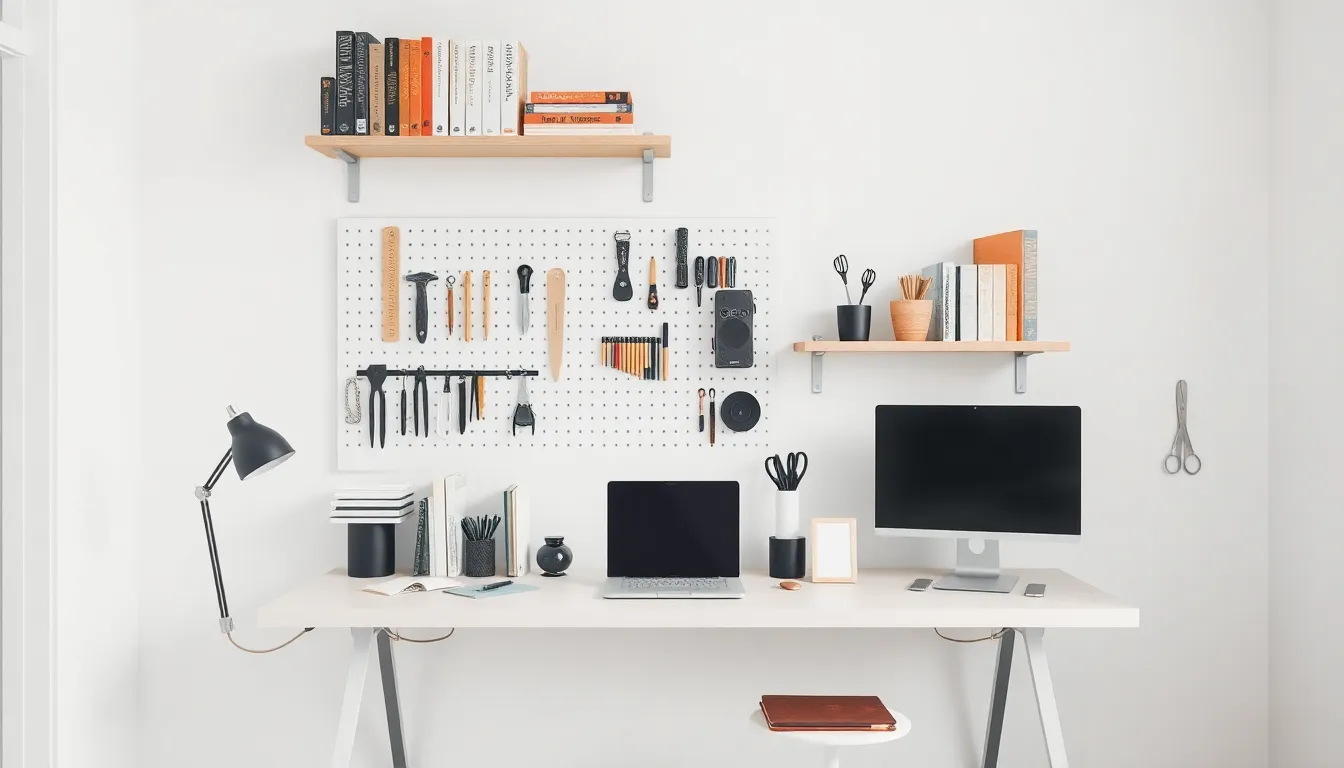
Maximizing our desk organization potential requires thinking beyond the desktop surface. Studies show that utilizing vertical space can improve productivity by up to 15%, making wall-mounted storage answers essential for maintaining an organized workspace.
Install Floating Shelves Above Your Desk
Floating shelves transform unused wall space into valuable storage real estate directly above our workspace. We can position frequently used items like books, binders, and office supplies within arm’s reach while keeping our desk surface completely clear. Installing these shelves at eye level or slightly above creates easy access without requiring us to stretch or strain during busy workdays.
The visual appeal of floating shelves contributes to a minimalist and calm environment that supports focus and productivity. We should space multiple shelves 12-18 inches apart to accommodate different item heights and prevent overcrowding. Choosing shelves with clean lines that match our desk’s aesthetic maintains a cohesive look throughout the workspace.
Add Pegboards for Hanging Tools and Supplies
Pegboards offer customizable hanging answers that adapt to our exact organizational needs. We can arrange hooks, bins, and small containers in any configuration to store stationery, cables, create materials, or frequently used tools. This flexibility allows us to reconfigure the storage system as our work requirements change over time.
Installing a pegboard above or beside our desk creates an organized display that keeps essential items visible and accessible. We should choose pegboard accessories that complement our workflow, such as mesh baskets for loose supplies or specialized hooks for headphones and cables. The modular nature of pegboards means we can add or remove components without permanent changes to our workspace.
Mount Magnetic Strips for Metal Items
Magnetic strips eliminate bulky desktop organizers while keeping metal office supplies instantly accessible. We can mount these strips under floating shelves or along the desk’s edge to hold scissors, paper clips, small tools, and other metal items securely in place. This storage method ensures these frequently used items remain visible and within easy reach.
The streamlined appearance of magnetic strips supports our organized aesthetic while maximizing functional storage space. We should position multiple strips at different heights to accommodate various item sizes and prevent overcrowding. Installing magnetic strips in high-traffic areas of our workspace reduces the time spent searching for essential tools during busy work sessions.
Organize Your Cables and Cords Effectively
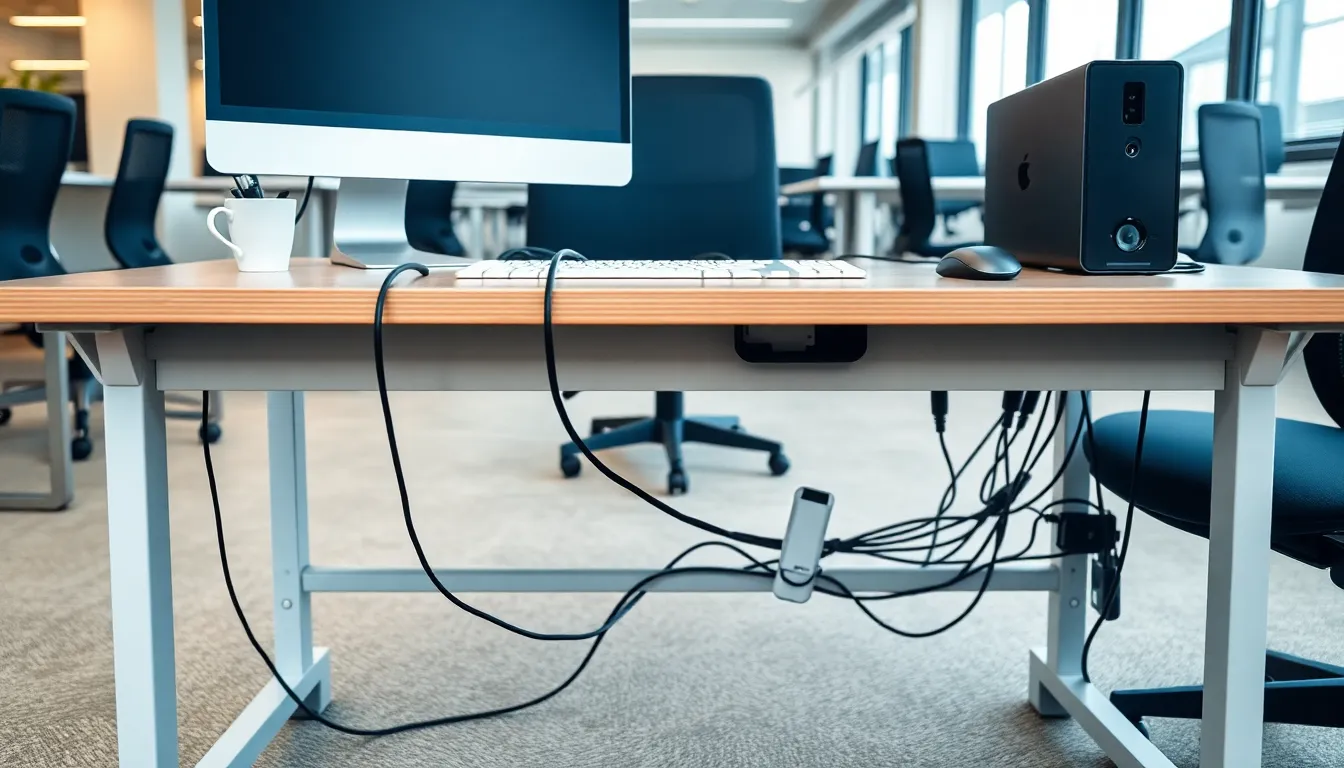
Tangled cables create visual chaos and make it difficult to maintain the clean workspace we’ve worked hard to establish. Let’s tackle this common problem with strategic cable management answers that’ll keep your desk looking professional and organized.
Use Cable Management Clips and Ties
Cable ties and velcro straps become your best friends when bundling cables that run in the same direction. We recommend grouping similar cords together, such as power cords and USB cables, to simplify your organization system. Keep enough slack in your bundled cables to maintain flexibility for future adjustments.
Zip ties offer a permanent solution for securing loose cords to your desk frame or existing cable management system. Position these ties strategically to prevent cables from dangling and creating visual clutter. Small adhesive cable clips can hold individual cables in place along your desk edges, guiding them exactly where you need them to go.
Install Under-Desk Cable Trays
Under-desk cable trays transform the hidden space beneath your workspace into an organized cable highway. Magnetic cable trays attach easily to metal desk frames and provide secure housing for multiple cables without requiring permanent installation. These trays keep cables off the floor, reducing tripping hazards while maintaining accessibility.
J-channel cable raceways mount directly to your desk or along countertops for discreet cable management. We’ve found these raceways particularly effective for routing cables between different devices while maintaining a clean appearance. Power strips can be mounted within these trays to centralize your electrical connections and eliminate floor clutter.
Label Each Cable for Easy Identification
Labels save countless hours when troubleshooting connectivity issues or rearranging your setup. Create clear, descriptive labels for each cable that identify both the source and destination devices. We suggest using a label maker or pre-printed cable labels for a professional appearance that won’t fade over time.
Color-coded labels or cable sleeves provide instant visual identification for different types of connections. Assign exact colors to categories like power cables, data cables, and audio connections. This system becomes especially valuable when managing multiple devices or when other people share your workspace.
Create a Functional Filing System
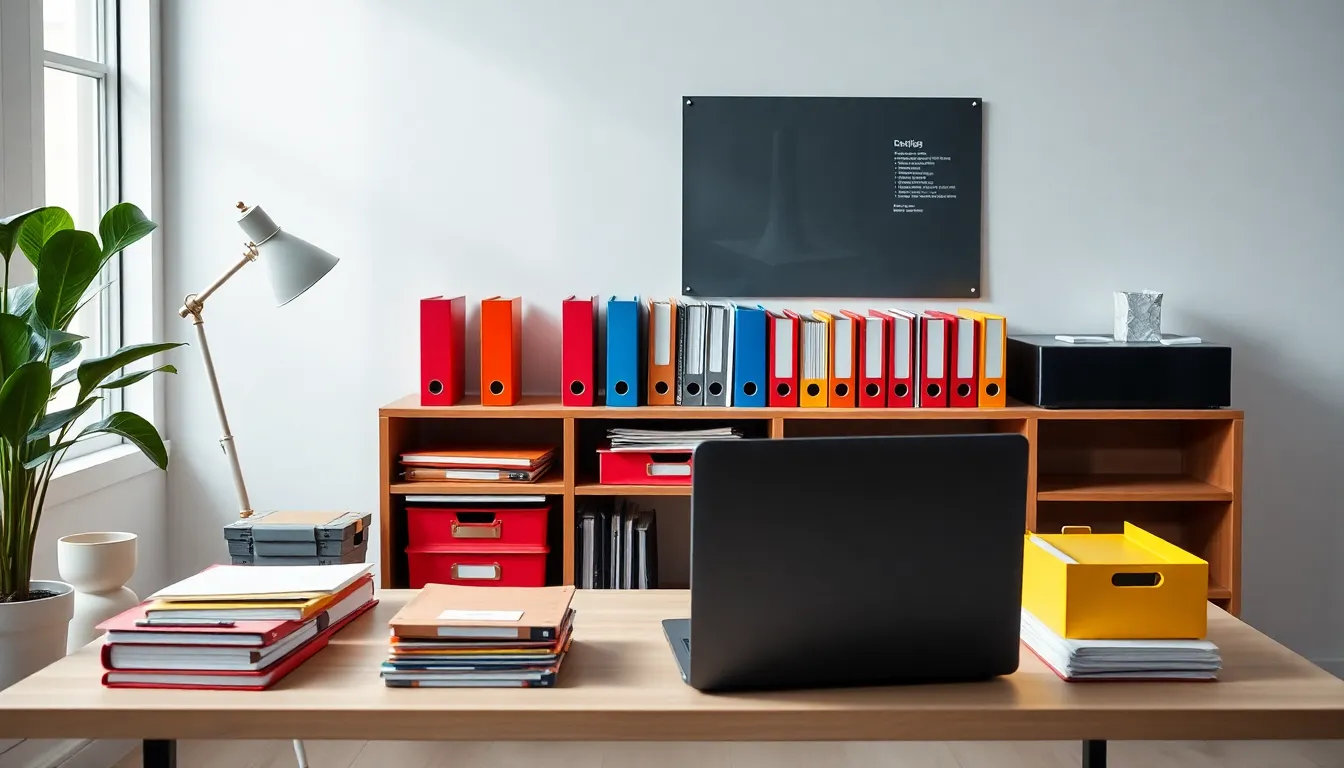
We’ll transform our document chaos into an organized system that saves time and reduces stress. Effective filing systems make information accessible while keeping our workspace clutter-free.
Sort Documents by Priority and Frequency
Priority-based sorting creates the foundation of an efficient filing system. We group documents into three categories: daily use items that stay within arm’s reach, weekly use materials in nearby drawers, and monthly or yearly documents in further storage locations.
Frequency analysis helps us determine document placement effectively. Active projects receive prime real estate on our desk or in the first drawer, while reference materials like manuals and contracts move to secondary storage areas.
Daily-use documents include current project files, today’s to-do lists, and immediate action items. Weekly materials cover recurring reports, meeting notes, and client correspondence that we reference regularly.
Use Color-Coded Folders and Labels
Color coding transforms our filing system into a visual navigation tool. We assign exact colors to different categories: red for urgent deadlines, blue for client files, green for financial documents, and yellow for personal projects.
Visual identification reduces search time by 40% according to productivity studies. We create a color legend that everyone in our workspace can follow, ensuring consistency across all filing systems.
Labeling complements our color system with clear, descriptive text. We write category names and subcategories on each folder tab, making documents findable even when colors aren’t immediately visible.
Consistent naming conventions streamline our labeling process. We use formats like “Client Name – Project Type – Date” or “Department – Document Type – Month” for easy alphabetical sorting.
Carry out a Digital Filing System
Digital archives eliminate physical storage limitations while improving accessibility. We scan important documents using smartphone apps or desktop scanners, creating searchable PDF files that sync across all our devices.
Cloud storage platforms like Google Drive or Dropbox provide secure backup options for our digital files. We mirror our physical filing structure in digital folders, maintaining consistency between both systems.
Searchable file names make document retrieval instantaneous. We include relevant keywords in filenames: dates, project names, and document types that help us locate files quickly through search functions.
Regular maintenance keeps our digital system current and useful. We schedule monthly reviews to delete outdated files, update folder structures, and ensure our digital filing remains as organized as our physical workspace.
Designate Drawer Space for Specific Items
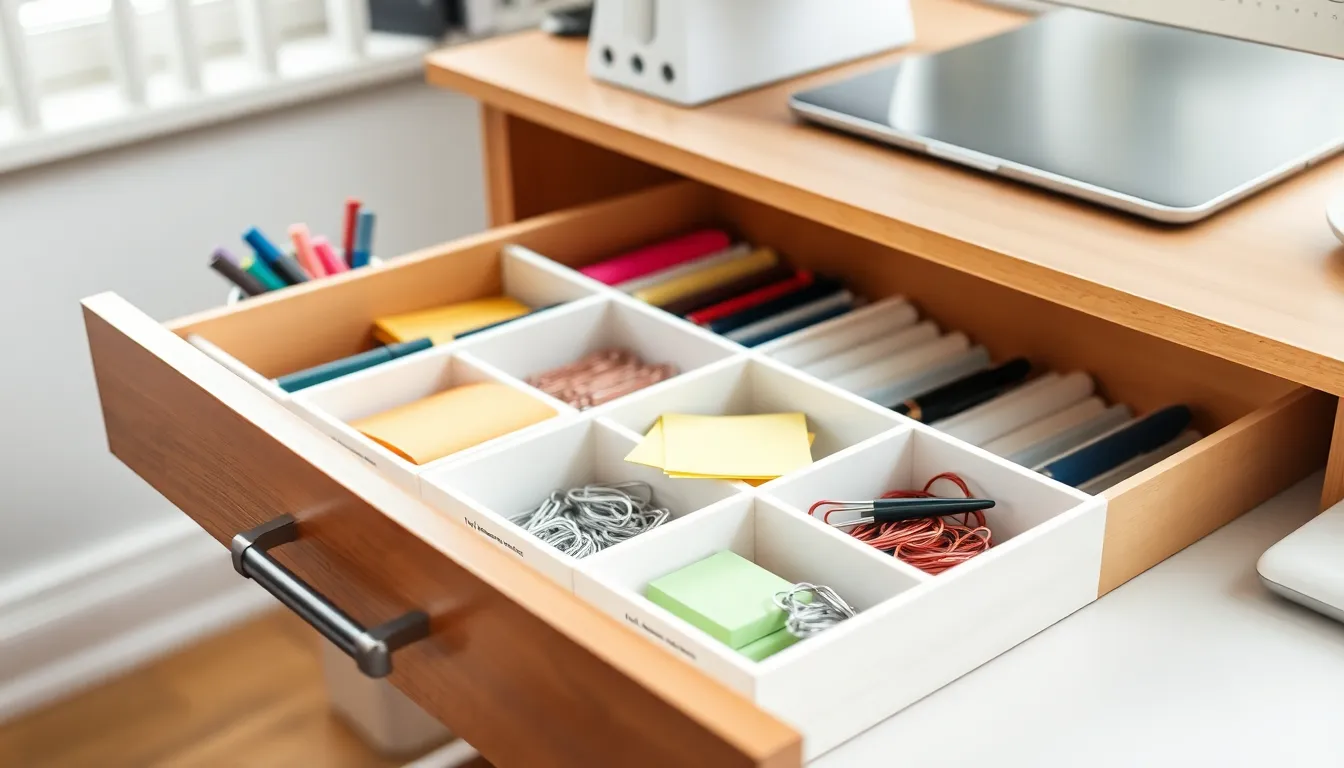
Transforming your desk drawers from chaotic catch-alls into organized storage zones will dramatically improve your daily workflow efficiency. Strategic drawer organization creates a systematic approach to storing essential items while maintaining the clean desk surface we’ve established.
Assign Each Drawer a Exact Purpose
Successful drawer organization begins with designating each drawer for a particular category of items rather than mixing everything together. We recommend assigning your top drawer to daily essentials like pens, staplers, and frequently used office supplies for immediate access. Reserve your second drawer for important documents such as contracts, invoices, and reference materials that you need weekly. Transform your bottom drawer into a storage space for backup supplies, personal items, or seasonal materials that you access less frequently.
Creating these exact zones prevents the common problem of hunting through multiple drawers to find what you need. Label each drawer clearly on the outside or inside edge so everyone in your workspace knows exactly where items belong. This systematic approach reduces decision fatigue since you’ll automatically know where to place items when tidying up your desk.
Use Drawer Dividers and Organizers
Drawer dividers transform large empty spaces into manageable compartments that keep similar items grouped together. We suggest using adjustable dividers that can accommodate different sized items like paper clips, rubber bands, and USB drives without creating wasted space. Small containers or trays work exceptionally well for organizing tiny items such as pushpins, batteries, and business cards that tend to scatter throughout drawers.
Invest in expandable drawer organizers that can grow with your storage needs and adapt to different drawer sizes. These organizers prevent items from sliding around when you open and close drawers, maintaining your organized system over time. Clear plastic dividers allow you to see contents at a peek, while solid dividers create clean visual boundaries between different categories of supplies.
Keep Frequently Used Items in Top Drawers
Positioning your most frequently used items in top drawers eliminates unnecessary bending and searching throughout your workday. We recommend storing daily essentials like writing instruments, sticky notes, and calculators in your uppermost drawer for effortless access. Reserve lower drawers for items you use weekly or monthly, such as reference materials, backup supplies, or specialty tools.
This strategic placement follows ergonomic principles that reduce physical strain while improving your productivity flow. Studies show that organizing frequently used items within easy reach can save up to 30 minutes per day that would otherwise be spent searching for supplies. Consider creating a small inventory list of your most used items to ensure they always have designated spots in your top drawer space.
Establish Daily and Weekly Cleaning Routines
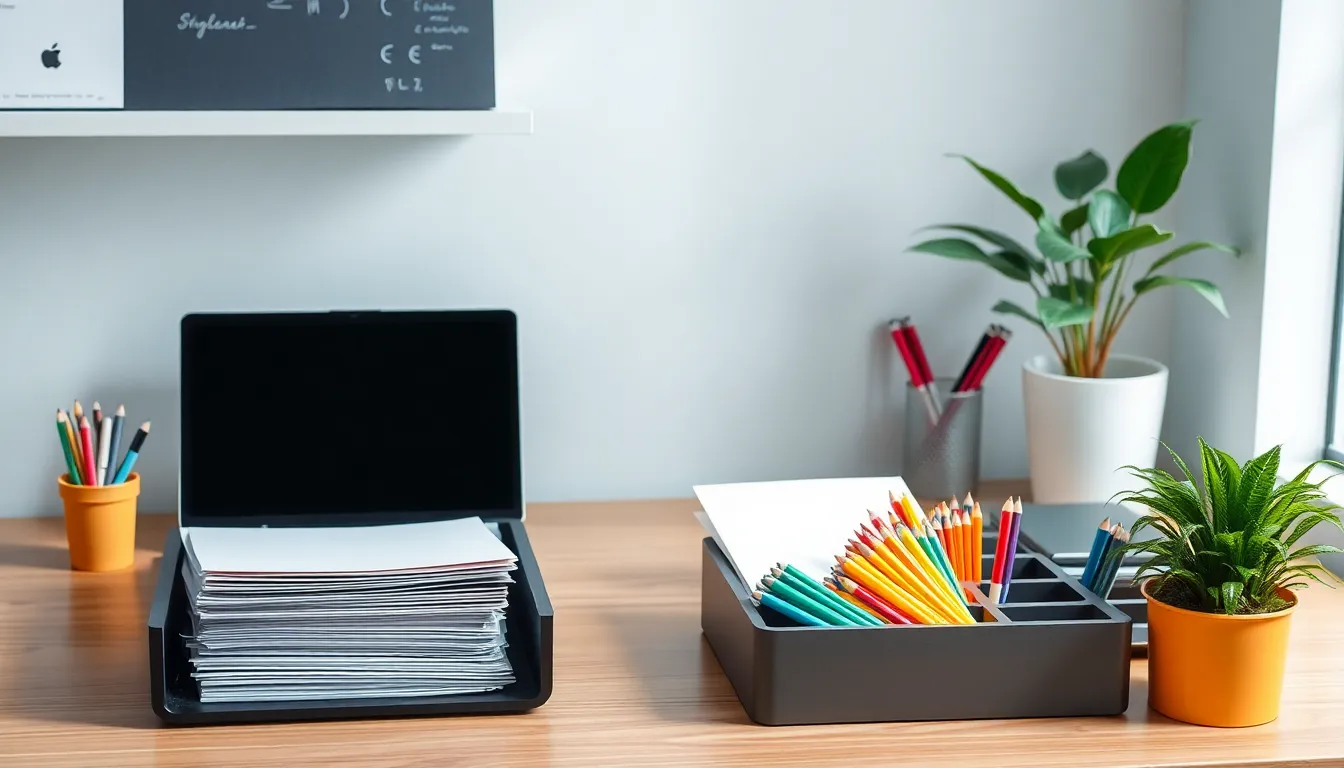
Consistent cleaning routines serve as the backbone of sustainable desk organization, preventing clutter from accumulating and maintaining the organized systems we’ve implemented. These structured approaches ensure our workspace remains productive and professional without requiring overwhelming time commitments.
End Each Day with a Five-Minute Cleanup
Dedicating five minutes at the end of each workday creates a powerful habit that transforms our workspace overnight. We clear all papers from the desk surface, returning documents to their designated folders and filing systems. Coffee cups and water bottles get removed immediately, while pens and supplies return to their organized compartments within our desk organizers.
Personal items like phone chargers and headphones find their way back to designated storage zones, maintaining the clean boundaries we’ve established. We quickly scan for any items that don’t belong in our workspace, relocating them to their proper locations throughout the office or home. This brief routine eliminates the morning stress of facing a cluttered desk and allows us to start each day with a clear, focused mindset.
Clearing our computer desktop of unnecessary files and closing unused applications completes the digital portion of our cleanup routine. We empty the trash bin if needed and ensure our workspace reflects the professional standards we’ve set for productivity and organization.
Schedule Weekly Deep Organization Sessions
Weekly deep organization sessions provide the opportunity to address areas that daily cleanup routines can’t fully maintain. We dedicate 30 to 45 minutes each week to thoroughly organizing our filing systems, ensuring documents remain in their correct categories and locations. Supply inventories get assessed during these sessions, allowing us to restock essential items before they run out completely.
Deep cleaning involves wiping down all surfaces, including our desk organizers, computer monitors, and keyboard areas that accumulate dust and debris over time. We reorganize our vertical storage answers, adjusting shelf contents based on changing project needs and priorities. Cable management systems receive attention during these sessions, with loose cords getting secured and any new devices properly integrated into our organization system.
Storage containers and drawer organizers get emptied and cleaned, ensuring they continue to function effectively in maintaining our organized workspace. We evaluate whether our current organization systems still meet our needs, making adjustments to improve efficiency and productivity.
Create Maintenance Checklists
Maintenance checklists ensure we don’t overlook critical areas of our desk organization system during routine cleaning sessions. We create daily checklists that include clearing the desk surface, organizing supplies in their designated containers, and maintaining our established work zones. Weekly checklist items cover deeper organization tasks like filing document backlogs, cleaning storage organizers, and assessing supply levels.
Monthly checklist components address long term maintenance needs, such as evaluating our filing system effectiveness and reorganizing seasonal or project exact materials. We include ergonomic assessments in our checklists, ensuring our workspace setup continues to promote comfort and reduce physical strain. Technology maintenance items get incorporated, covering tasks like organizing digital files and updating our cable management systems.
Accountability measures within our checklists help track consistency and identify areas where our organization systems need improvement. We customize these checklists based on our exact workspace needs and the complexity of our organization systems, ensuring they remain practical and achievable rather than overwhelming.
Personalize Your Space While Maintaining Order
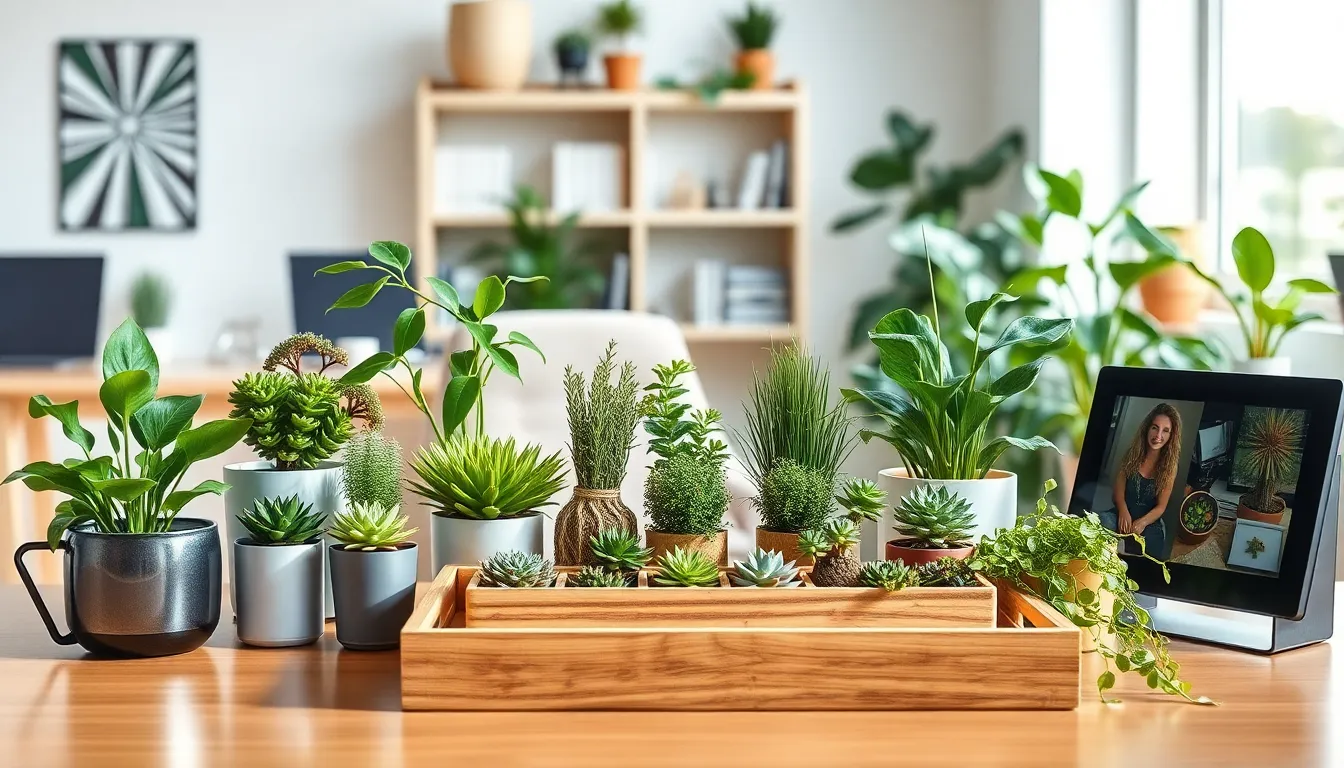
Creating a workspace that reflects your personality while staying organized doesn’t have to be a balancing act. We can seamlessly blend personal touches with functional design to boost both productivity and job satisfaction.
Add Plants for Natural Organization Motivation
Plants offer benefits that extend far beyond visual appeal in our workspace. Adding greenery to our desk area naturally boosts mood and increases productivity while creating subtle boundaries between different work zones. Succulents like echeveria or jade plants require minimal maintenance yet provide maximum impact for busy professionals.
Small potted herbs such as basil or mint can serve dual purposes by adding fragrance and providing fresh ingredients for afternoon tea breaks. We recommend positioning plants strategically to create natural dividers between our keyboard area and filing sections. Desktop planters with built-in water reservoirs help maintain plant health without creating mess or requiring daily attention.
Hanging planters work exceptionally well for vertical spaces above our monitor, maximizing desk surface area while adding life to the workspace. Snake plants and pothos varieties thrive in office lighting conditions and naturally purify the air we breathe throughout long work sessions.
Display Inspiring Quotes or Photos Strategically
Strategic placement of motivational elements can transform our workspace without creating visual clutter. We should position inspiring quotes within our direct line of sight during natural work breaks, such as on the wall behind our monitor or on a small easel beside our keyboard.
Family photos work best when placed at eye level during brief moments of pause, typically to the right or left of our primary work area. Digital picture frames offer flexibility by rotating multiple images throughout the day while maintaining a clean, organized appearance.
Motivational artwork should complement our color scheme rather than compete with it for attention. We can use small acrylic stands to display rotating quotes or goals, making it easy to update our inspiration as projects and priorities change. Cork boards with decorative frames allow us to pin meaningful notes or achievements without permanent wall mounting.
Choose Aesthetically Pleasing Storage Options
Storage answers that combine functionality with visual appeal create a workspace we actually enjoy using. Three-tiered trays in materials like bamboo or metal help us categorize documents by urgency while adding sophisticated style to our desk surface.
Decorative boxes serve as excellent hiding spots for cables, backup supplies, and personal items that don’t need daily access. We should select storage containers that match our existing color palette, whether that’s sleek black organizers for modern offices or warm wooden options for traditional spaces.
Vertical organizers like pegboards can be customized with attractive hooks and containers that make essential items easily accessible. Label makers with clear, professional fonts help us maintain organization systems while keeping everything looking intentional and polished.
Glass containers work particularly well for frequently used supplies like paper clips or rubber bands, allowing us to see contents at a peek while maintaining a clean aesthetic. Drawer dividers in coordinating materials help compartmentalize smaller items without sacrificing the visual cohesion of our organized workspace.
Conclusion
A well-organized desk isn’t just about aesthetics—it’s a powerful tool that directly impacts our productivity and mental well-being. We’ve covered the essential building blocks: maintaining clean surfaces through daily routines implementing smart storage answers and creating functional systems that work for our exact needs.
The key lies in consistency. By dedicating just a few minutes each day to maintaining our workspace and following the strategies we’ve outlined we can transform even the most chaotic desk into a productivity powerhouse.
Remember that organization is personal. What works for one person might not work for another so we encourage you to experiment with these techniques and adapt them to fit your unique work style and space constraints.
Start small choose one or two strategies that resonate most with you and build from there. Your future productive self will thank you for taking action today.
Frequently Asked Questions
How can I quickly declutter my workspace daily?
Dedicate just 5 minutes at the end of each workday to clear your desk surface. Remove unnecessary items, file important documents, and organize supplies back to their designated places. This simple routine prevents clutter accumulation and ensures you start each day with a clean, focused workspace that enhances productivity.
What is the “one-touch rule” for workspace organization?
The one-touch rule means handling each piece of paper, email, or notification only once when you encounter it. Instead of setting items aside for later, immediately decide whether to file it, act on it, or discard it. This eliminates decision fatigue and prevents paperwork from piling up on your desk.
How do I create designated zones on my desk?
Divide your desk into specific areas for different tasks: a writing zone with pens and notebooks, a computer zone for digital work, and an inbox zone for incoming documents. Use drawer dividers, small containers, or desk organizers to physically separate these areas and maintain clear boundaries between different work functions.
What storage solutions work best for small workspaces?
Invest in multi-compartment desk organizers, vertical file holders, and small containers for loose supplies. Utilize vertical space with floating shelves above your desk and pegboards for customizable hanging storage. These solutions maximize storage capacity while keeping frequently used items accessible and maintaining a clutter-free surface.
How can I manage tangled cables and cords effectively?
Use cable management clips and zip ties to bundle similar cords together. Install under-desk cable trays to keep cables off the floor and organized. Label each cable for easy identification, and consider color-coded sleeves for quick visual recognition. This prevents visual chaos and makes it easier to manage multiple devices.
What’s the best way to organize important documents?
Create a filing system based on priority and frequency of use. Sort documents into daily, weekly, and monthly categories using color-coded folders for quick identification. Implement a digital filing system by scanning important documents and storing them in organized cloud folders that mirror your physical filing structure.
How should I organize my desk drawers efficiently?
Designate each drawer for specific categories: daily essentials in the top drawer, important documents in the middle, and backup supplies at the bottom. Use drawer dividers to keep similar items grouped together. Store frequently used items in easily accessible top drawers to reduce physical strain and improve workflow efficiency.
What daily routines help maintain desk organization?
Establish a 5-minute end-of-day cleanup routine to clear your desk surface and organize supplies. Implement weekly deep organization sessions to address filing systems and assess supply inventories. Create maintenance checklists with daily, weekly, and monthly tasks to ensure consistent organization and prevent clutter buildup over time.
How can I personalize my workspace without creating clutter?
Add low-maintenance plants like succulents to boost mood and productivity. Display inspiring quotes and photos strategically without overcrowding surfaces. Choose aesthetically pleasing storage solutions like decorative boxes and tiered trays that combine functionality with style, allowing personal expression while maintaining organization and efficiency.
What are the benefits of maintaining an organized workspace?
An organized workspace enhances focus, reduces stress, and improves productivity by eliminating visual distractions. It saves time spent searching for items, reduces decision fatigue, and creates a more professional appearance. Additionally, it promotes better mental clarity and workflow efficiency, leading to increased job satisfaction and overall performance.







